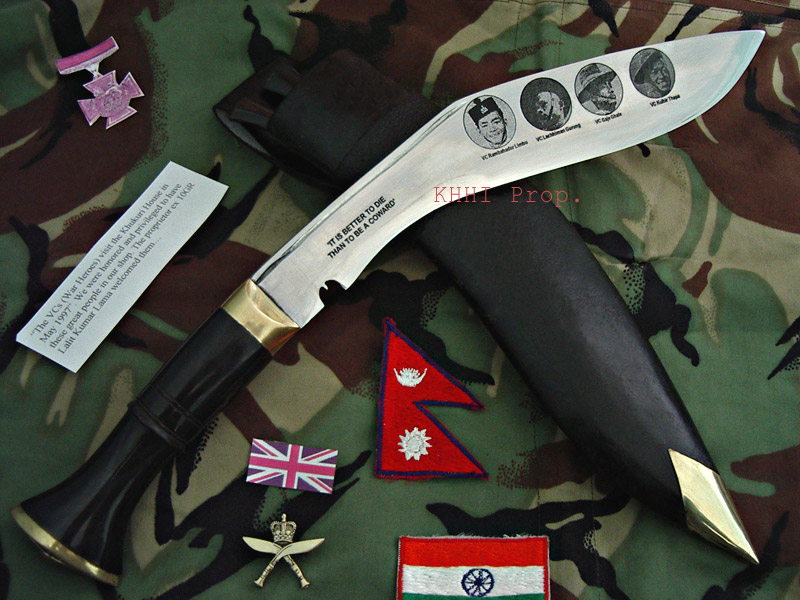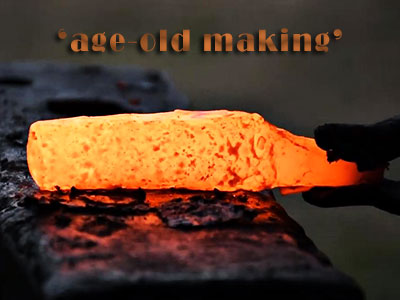Gurkhas Info
Khukuri of the Month
Blade Size (in): 2.5 in (SUKx 1)
Weight (gm): 100
USD 17.99
Gurkha VCs
- Home
- Gurkha VCs
Gurkha VC (Victoria Cross) Holders
The award for bravery that is only entitled to audacious heart; for the LION HEART

 It is the pinnacle of all army medals. Victoria Cross (VC) is British highest gallantry award given to military personnel for the ultimate act of bravery and selflessness in the line of duty by the British Government. It is a décor for valor, a greatest honor, a sign of heroism and optimum sacrifice made by a soldier when duty calls. As Nepalese we feel proud to mention that Twenty Six (26) Victoria Cross have been won by Gurkha Regiments so far, among them Nepalese Gurkhas alone have won thirteen VCs including many other bravery awards.
It is the pinnacle of all army medals. Victoria Cross (VC) is British highest gallantry award given to military personnel for the ultimate act of bravery and selflessness in the line of duty by the British Government. It is a décor for valor, a greatest honor, a sign of heroism and optimum sacrifice made by a soldier when duty calls. As Nepalese we feel proud to mention that Twenty Six (26) Victoria Cross have been won by Gurkha Regiments so far, among them Nepalese Gurkhas alone have won thirteen VCs including many other bravery awards.
Bravery is synonyms to Gurkhas, it is in the blood. It is a gift they have inherited from their forefathers and carry it with vanity. The harsh terrains and difficult livelihood have made them hardy and daring. These rural people made great warriors who exhibited exemplarily military prowess and the will to sacrifice. Their loyalty, bravery and the skills have never been questioned. This is the very reason why Gurkhas probably deserve the highest award more than anybody.
A brave heart, humble soul and a terrific warrior. Jai Gurkha! Jai Kukri !!
Below listed are the Gurkha VC holders with whose bravery, gallantry and loyalty have recognized Gurkhas as the worlds most formidable & feared soldiers.
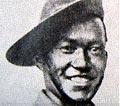 RIFLEMAN KULBIR THAPA
RIFLEMAN KULBIR THAPA
3rd Gurkha Rifles, France
25/26th September 1915
From most conspicuous bravery during operations against the German trenches south of Mauquissant. When himself wounded, on the 25 September 1915, he found a badly wounded soldier of the 2nd Leicestershire Regiment behind the first line German trench, and, though urged by the British soldiers to save himself, he remained with him all day and night. In the early morning of the 26 September, in misty weather, he brought him out through the German wire, and leaving him in a place of comparative safety returned and bought in two wounded Gurkhas one after the other. He then went back in broad day light for the British soldier, and brought him in also, carrying him most of the way and being at most points under the enemy's fire.
- London Gazette (18 November 1915)
 SUBADAR LALBAHADUR THAPA
SUBADAR LALBAHADUR THAPA
2nd Gurkha Rifles, Tunisia
5/6th April 1943
On the night of 5-6 April, during the silent attack on the Rass-Ez-Zouai feature, Subadar Lalhahadur Thapa was Second-in-Command of D Company....
…. The garrison of the outer posts were all killed by Subadar Lalbahadur Thapa and his men by kukri or bayonet in the first rush and the enemy then opened very heavy fire straight down the narrow enclosed pathway and steep arena sides. Subadar Lalbahadur Thapa led his men on and fought his way up the narrow gully straight through the enemy's fire, with little room to maneuver, in the face of intense and sustained machine-gun concentrations and the liberal use of grenades by the enemy.
Next the machine-gun posts were dealt with, Subadar Lalbahadur Thapa personally killing two men with his Kukri and two more with his revolver. This Gurkha Officer continued to fight his way up the narrow bullet-swept approaches to the crest. He and two riflemen managed to reach he crest where Subadar Lalbahadur Thapa killed another two more enemies with his kukri and the rest fled. He then secured the whole feature and covered his company's advance up the defile.......
Extract from London Gazette (June 1943)
 HAVILDAR GAJE GHALE
HAVILDAR GAJE GHALE
5th Gurkha Rifles, Burma
27th May 1943
...While preparing for the attack, the platoon came under heavy mortar fire but Havildar Gaje Ghale rallied them and led them forward.
Approaching to close range of the well-entrenched enemy, the platoon came under withering fire and this NCO was wounded in the arm, chest and leg by an enemy hand grenade. Without pausing to attend to his serious wounds and with no heed to the intensive fire from all sides, Gaje Ghale closed his men and led them to close grips with the enemy when a bitter hand to hand struggle ensued.
Havildar Gaje Ghale dominated the fight by his outstanding example of dauntless courage and superb leadership. Hurling hand grenades covered in blood from his own neglected wounds, he led assault after assault, encouraging his platoon by shouting the Gurkha's battle-cry “Aayo Gurkhali”. Spurred on by the irresistible will of their leader to win, the platoon stormed and carried the hill by a magnificent all out effort and inflicted very heavy casualties on the Japanese.
Extract from London Gazette (September 1943)
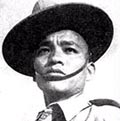 RIFLEMAN TULBAHADUR PUN
RIFLEMAN TULBAHADUR PUN
6th Gurkha Rifles, Burma
23rd June 1944
.Rifleman Tulbahadur Pun then seized the Bren gun, and firing from the hip as he went, continued the charge on this heavily bunkered position alone, in the face of the most shattering concentration of automatic fire, directed straight at him. With the dawn coming up behind him, he presented a perfect target to the Japanese. He had to move for thirty yards over open ground, ankle deep in mud, though Shell holes and over fallen trees.
Despite these overwhelming odds, he reached the Red House and closed with the Japanese occupants. He killed three and put five more to right and captured tow light machine-guns and much ammunition. He then gave accurate supporting fire from the bunker to the remainder of his platoon which enabled them to reach their objective....
Extract from London Gazette (November 1944)
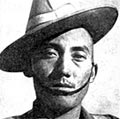 NAIK AGAMSING RAI
NAIK AGAMSING RAI
5th Gurkha Rifles, Burma
26th June 1944
......This position was now under intense fire form the .37 millimeter gun in the jungle and from 'Water Piquet', Naik Agamsing Rai at once advanced towards the gun, his section without hesitation following their gallant leader. Intense fire reduced the section to three men before half the distance had been covered but they pressed on to their objective. Arriving at close range, Naik Agamsing Rai killed three of the crew and his men killed the other two. The party then returned to 'Mortar Bluff' where the rest of their platoon were forming up for the final assault on 'Water Piquet'. In the subsequent advance, heavy machine-gun fire and showers of grenades from an isolated bunker position caused further casualties. Once more, with indomitable courage, Naik Agamsing Rai, covered by his Bren gunner advanced alone with a grenade in one hand and his Thompson sub-machine gun in the other. Through devastating fire he reached the enemy position and with his grenade and bursts form his Thompson sub-machine gun killed all four occupants of the bunker.....
Extract form London Gazette (October 1944)
His VC Medal has been auctioned for the poor.
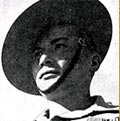 RIFLEMAN GANJU LAMA MM
RIFLEMAN GANJU LAMA MM
7th Gurkha Rifles, Burma
12th June 1944 …. ‘B’ Company, 7th Gurkha Rifles was ordered to counter-attack and restore the situation. Shortly after passing the starting line it came under heavy enemy medium machine-gun fire at point blank range, which covered all lines of approach. Rifleman Ganju Lama, the No.1 of the PIAT gun, on his own initiative, with great coolness and complete disregard for his own safety, crawled forward and engaged the tanks single handed. In spite of a broken left wrist and two other wounds, one in his right hand and one in his leg, cause by withering cross fire concentrated upon him, Rifleman Ganju Lama succeeded in bringing his gun into action within thirty yards of the enemy tanks and knocked out first one and then another, the third tank being destroyed by an anti tank gun.
In spite of his serious wounds, he then moved forward and engaged with grenades the tank crews, who now attempted to escape. Not until he had killed them all, thus enabling his company to push forward, did he allow himself to be taken back to the Regimental Aid post to have his wounds dressed…
Extract from London Gazette (September 1944)
 RIFLEMAN THAMAN GURUNG
RIFLEMAN THAMAN GURUNG
5th Gurkha Rifles, Italy
10th November 1944
.....By Skilful Stalking both scouts reached the position undetected... Realizing that if the enemy opened fire the section would sustain heavy casualties, Rifleman Thaman leapt to his feet and charged. The enemy completely taken by surprise surrendered without opening fire.
He then crept to the summit from which he saw a party a Germans well dug in on the reverse slopes.....Riifleman Thaman crossed the bare skyline firing his tommy gun, thus allowing the forward section to reach the summit.
Soon afterwards, due to heavy enemy machine-gun fire, the fighting patrol was ordered to withdraw. Rifleman Thaman then again crossed the skyline alone, firing burst upon burst of tommy gun fire until his ammunitition ran out. Having thrown two grenades he rejoined his section, collected two more grenades and crossing the skyline for the third time hurled them at the remaining Germans.
This diversion enabled both rear sections to withdraw. Meanwhile the leading section was still on the Summit, so Thaman seized a Bren gun, ran yet again to the skyline, emptied two magazines into the enemy position and then with the remaining section well on its way to safety turned to follow them, and at that very moment spun and fell with a bullet through his throat.
Extract form London Gazette (February 1945)
 RIFLEMAN BHANBHAGTA GURUNG
RIFLEMAN BHANBHAGTA GURUNG
2nd Gurkha Rifles, Burma
5th March 1945 ....Rifleman Bhanbhagta without waiting for orders dashed forward alone to attack the first foxhole. With tow grenades he killed both occupants and without hesitation rushed o to clear three more foxholes single handed with bayonet and grenade. Realizing that a light machine gun now firing on him would hold up not only his own platoon behind him but also another approaching from the west, Bhanbhagta for the fifth time advanced alone under heavy enemy fire to knock out this position.
Doubling forward he leapt on to the roof of the bunker from where, his hand grenades being finished, he flung two smoke grenades into the slit. Two Japanese rushed out partially blinded by the smoke and Bhanbhagta promptly killed them both with his kukri. Another Japanese inside the bunker was still firing the gun, holding up the advance of the platoons, so Bhanbhagta crawled inside, killed this remaining gunner and captured the gun.
Extract from London Gazette (June 1945)
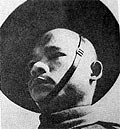
RIFLEMAN LACHIMAN GURUNG
8th Gurkha Rifles, Burma
12/13th May 1945
....Before assaulting, the enemy hurled innumerable grenades at the position from close range. One grenade fell on the lip of Rifleman Lachhiman Gurung's trench; he at once grasped it and hurled it back at the enemy. A second grenade landed in his trench, again this Rifleman snatched it up and threw it back. A third grenade then fell just in front of the trench. He attempted to throw it back but it exploded in his hand, blowing off his finger, shattering his right arm and severely wounding him in the face, body and right leg. His two comrades were also badly wounded and lay helpless in the button of the trench.
The enemy, screaming and shouting, now formed up shoulder to shoulder and attempted to rush the position by sheer weight of numbers. Rifleman Lachhiman Gurung, regardless of his wounds, fired and loaded his rifle with his left hand, maintaining a continuous and steady rate of fire. Wave after wave of fanatical attacks were thrown in by the enemy during the next four hours and all were repulsed with heavy casualties...
Extract from London Gazette (June 1945)
“If we didn’t kill them, they’d kill us.” – VC Lachhiman Gurung; in his own words >>
 LANCE CORPORAL RAMBAHADUR LIMBU
LANCE CORPORAL RAMBAHADUR LIMBU
10th Gurkha Rifles, Borneo
21st November 1965
...  Rushing forward he hurled self on the ground beside one of the wounded and calling for support from two light machine guns which had now come up to his right in support he picked up the man and carried him to safety out of the line of fire. Without hesitation he immediately returned to the top of the hill determined to complete his self-imposed task of saving those for whom he felt personally responsible. It was now clear from increased weight of fire being concentrated on the approaches to and in the immediate vicinity of the remaining casualty the enemy were doing all they could to prevent any further attempts at rescue. However, despite this, lance Corporal Rambahadur Limbu again moved out into the open for his final effort. In a series of short forward rushes, and once being pinned down for some minutes by the intense and accurate automatic fire which could be seen striking the ground all round him, he eventually reached the wounded man. Picking him up and unable now to seek cover he carried him back as fast as he could through the hail of enemy bullets. For all but a few seconds this young NCO had been moving alone in full view of the enemy and under the continuous aimed fire of their automatic weapons. That he was able to achieve what he did against such overwhelming odds without being hit is miraculous.
Rushing forward he hurled self on the ground beside one of the wounded and calling for support from two light machine guns which had now come up to his right in support he picked up the man and carried him to safety out of the line of fire. Without hesitation he immediately returned to the top of the hill determined to complete his self-imposed task of saving those for whom he felt personally responsible. It was now clear from increased weight of fire being concentrated on the approaches to and in the immediate vicinity of the remaining casualty the enemy were doing all they could to prevent any further attempts at rescue. However, despite this, lance Corporal Rambahadur Limbu again moved out into the open for his final effort. In a series of short forward rushes, and once being pinned down for some minutes by the intense and accurate automatic fire which could be seen striking the ground all round him, he eventually reached the wounded man. Picking him up and unable now to seek cover he carried him back as fast as he could through the hail of enemy bullets. For all but a few seconds this young NCO had been moving alone in full view of the enemy and under the continuous aimed fire of their automatic weapons. That he was able to achieve what he did against such overwhelming odds without being hit is miraculous.
Extract from London Gazette (April 1966)
Brief Article of RamBahadur Limbu life (action, bravery, award & the tragedy)
 RIFLEMAN KARANBAHADUR RANA
RIFLEMAN KARANBAHADUR RANA
3rd Gurkha Rifles, Palestine
10th April 1918 "For most conspicuous bravery, resource in action under adverse conditions, and utter contempt for danger.
During an attack he, with a few other men, succeeded under intense fire in creeping forward with a Lewis gun in order to engage an enemy machine gun which had caused severe casualties to officers and other ranks who had attempted to put it out of action.
No 1 of the Lewis gun opened fire, and was shot immediately. Without a moment's hesitation Rifleman Karanbahadur Rana pushed the dead man off the gun, and in spite of bombs thrown at him and heavy fire from both flanks, he opened fire and knocked out the machine-gun crew; then, switching his fire on to the enemy bombers and riflemen in front of him, he silenced their fire. He kept his gun in action and showed the greatest coolness in removing defects which on two occasions prevented the gun from firing. During the remainder of the day he did magnificent work, and when a withdrawal was ordered he assisted with covering fire until the enemies were close on him. He displayed throughout a very high standard of valor and devotion to duty".
London Gazette 21 (June 1918)
 SUBADAR NETRABAHADUR THAPA
SUBADAR NETRABAHADUR THAPA
5th Gurkha Rifles, Burma
25/26th June 1944 "Subadar Netrabahadur Thapa was in command of the isolated piquet known as Mortar Bluff... Owing to its commanding position the retention of Mortar Bluff was vital to the safety of other positions further down the ridge and to Bishenpur itself.
...The enemy began to attack. For this purpose a 75 millimeter and a 37 millimeter gun poured shell after shell at point blank range for ten minutes into the narrow confines of the piquet, and this was followed by a determined attack by not less than one company of Japanese. A fierce fight ensued in which Subadar Netrabahadur Thapa's men, exhorted by their leader, held their ground against heavy odds and drove the enemy back with disproportionate losses...
...Still in considerable strength and as determined and ferocious as ever the enemy poured out from the jungle to the piquet defenses, both the L.M.G. and T.M.G. of one section jammed and the enemy over-ran this and another section, killing or wounding 12 out of the 16 men. Subadar Netrabahadur Thapa himself stemmed any further advance with grenades.
... At 0400 hours a section of 8 men with grenades and small arms ammunition arrived. Their arrival inevitably drew fire and all the 8 were soon casualties. Subadar Netrabahadur Thapa retrieved the ammunition and took the offensive. Whilst so doing he received a bullet wound in the mouth followed shortly afterwards by a grenade which killed him outright. His body was found next day, his kukri in hand and a dead Japanese with a cleft skull by his side.
...His find example of personal bravery and his high sense of duty so inspired his men that a vital position was held to the limit of human endurance..."
Extracts from London Gazette (12 October 1944)
 RIFLEMAN SHERBAHADUR THAPA
RIFLEMAN SHERBAHADUR THAPA
9th Gurkha Rifles, Italy
18/19th September 1944
"...Rifleman Sherbahadur Thapa was a number one Bren gunner in a rifle Company which... came under heavy enemy observed small arms and mortar fire. He and his section commander charged an enemy post, killing the machine gunner and putting the rest of the post to flight. Almost immediately another party of Germans attacked the two men and the section commander was badly wounded by a grenade, but, without hesitation, the Rifleman, in spite of intense fire, rushed at the attackers and reaching the crest of the ridge brought his Bren gun into action against the main body of the enemy who were counter-attacking out troops.
...By the intensity and accuracy of the fire which he could bring to bear only from the crest, this isolated Gurkha Bren gunner silenced several enemy machine guns and checked a number of Germans who were trying to infiltrate on to the ridge.
At the end of two hours both forward Companies had exhausted their ammunition and, as they were by then practically surrounded, they were ordered to withdraw. Rifleman Sherbahadur Thapa covered their withdrawal as they crossed the open ground to positions in the rear and himself remained alone at his post until his ammunition ran out. He then dashed forward under accurate small arms and mortar fire and rescued two wounded men, who were lying between him and the advancing Germans.
While returning the second time he paid the price of his heroism and fell riddled by machine gun bullets fired at point blank range.
The great bravery of this Gurkha soldier was instrumental in saving the lives of many of his companions and his outstanding devotion to duty contributed largely to the severe reverse which the enemy eventually suffered when our troops counter-attacked..."
Extracts from London Gazette (28 December 1944)
 Late King Birendra with the Gurkha VCs:
Late King Birendra with the Gurkha VCs:
Late King Birendra granting audience to Gurkha VCs at Narayanhity Royal Palace, Friday, 22nd May 1998. From Left to Right: VC Agamsing Rai, VC Ganju Lama, Late King Birendra, VC Bhanubhakta Gurung and VC Rambahadur Limbu.
"VCs visit the KHHI "
A memorial and prestigious event in KHHI nepal
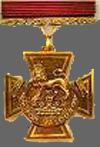 The maiden visit of VCs (Agan Singh Rai, Lacchiman Gurung and Ram Bahadur Limbu) to Khukuri House Handicraft Industry-KHHI in May 1997 was a big boost to the company. The visit was one of the major events in a decade of business. Khukuris were thoroughly inspected and admired by the war heroes and further recommended to be of the best quality. KHHI also sponsored a lunch program to honor the VCs. They were presented khukuris as a token of gifts from the owner. The event was a big success and KHHI will always remain grateful to the war heroes for their visit and priceless contribution to fame the Gurkhas, Nepalese and Nepal as a whole.
The maiden visit of VCs (Agan Singh Rai, Lacchiman Gurung and Ram Bahadur Limbu) to Khukuri House Handicraft Industry-KHHI in May 1997 was a big boost to the company. The visit was one of the major events in a decade of business. Khukuris were thoroughly inspected and admired by the war heroes and further recommended to be of the best quality. KHHI also sponsored a lunch program to honor the VCs. They were presented khukuris as a token of gifts from the owner. The event was a big success and KHHI will always remain grateful to the war heroes for their visit and priceless contribution to fame the Gurkhas, Nepalese and Nepal as a whole.
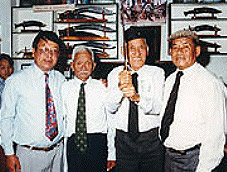
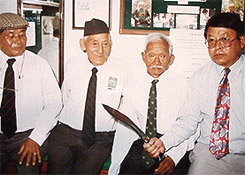
Proprietor Ex-10GR Lalit Kumar Lama, VC Lachhiman Gurung, VC Agansing Rai & VC Ram Bahadur Limbu at Khukuri House, May 1997
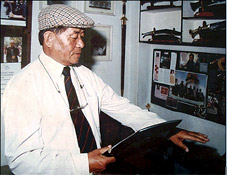
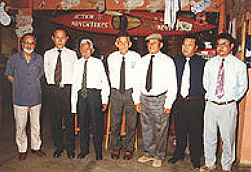
VC Ram Bahadur Limbu admiring Kukri made by Khukuri House VCs prior to lunch hosted by Khukuri House
Gurkha VC Khukuri, made for honoring the VCs winners >>
